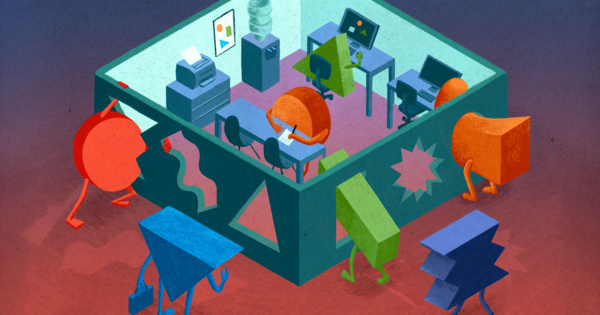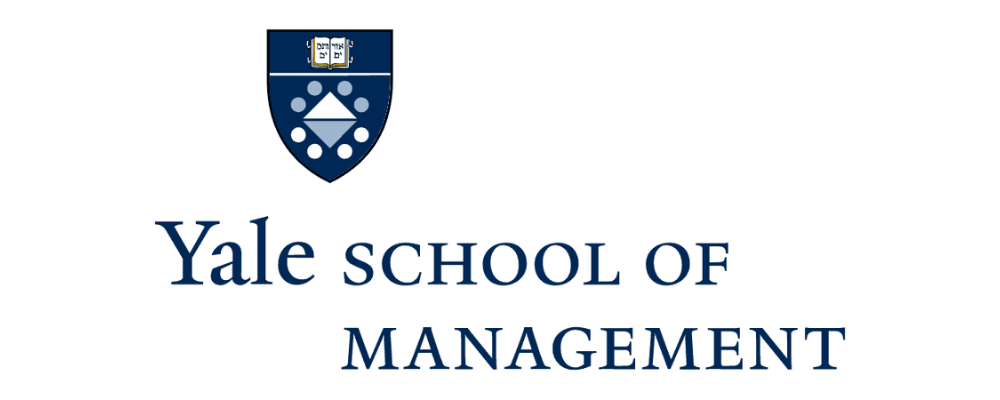
The last time we talked about returning to the office, you suggested that we take this opportunity to think about the workplace—not just how to organize workers and cubicles, and whether we mask, and what the hybrid policy is, but to assess how our organization works, and how we‘re working together as a team. Now it’s 2023. Do you think that those conversations are still needed?
Absolutely. For the most part, business people and executives are interested in solving problems that are in their subject-matter expertise. And re-envisioning work is not an area of expertise for most of them.
So we are re-envisioning work and having some trouble with the process. Part of what has happened is that people have tried to make it a problem that they can solve with the tools available, the kind of questions we are used to asking. What days should we all be in the office? How can we have time when people encounter each other, have spontaneous collisions? How can we recapture some of the liminal, in-between space where there was creativity about our shared work and also bonding and building familiarity? More recently, I’m seeing more bids for empathy skills re-emerging. I’m listing those questions in a way where they get increasingly towards what I think is the real issue, which is, what does it really mean to recraft being together in a world we have never quite visited before? It really escalated the priority of the future of work that’s now here. And it turns out we’re not ready.
Why not?
We don’t even know if we’re ready for new technology. We’re confused, and agitated and worried and fascinated, about AI and ChatGPT. This is supposed to be humanity at its smartest and best, producing technical excellence—we‘re not even ready for ourselves.
We don’t know how to really be in a world where we don’t have the answers and we disagree about even how we see the issues. And these are the kind of questions that are coming up about what it means to work together.
On the other side of the equation, how do we ask questions that don’t use our very refined and familiar problem-solving mindset? We’re so ready to be a heat-seeking missile towards a problem we can solve and get our heads and hands around. But our problem-solving muscles are not equipped for a different set of questions, like people asking, who am I at work now? That’s not a problem to be solved. It’s a question to sit with and get curious about.
We were tragically disturbed by the pandemic. Our survival was threatened. We’ve also, in the last three years, faced very deep questions of racial equity in the workplace, and foundational questions about whether our planet is safe and whether we ourselves are the greatest threat. We are at war in certain ways, and we’re not quite sure what that means for each and all of us.
We have been and continue to be disturbed by really fundamental questions of what it means to be human. And we don’t know how to really be in a world where we don’t have the answers and we disagree about even how we see the issues. And so these are the kind of questions that are coming up about what it means to work together. We think the question is, should we all be in the office on Friday? The question is actually more, do we even want to work? What is work? And why is work? How can we expand our experience of work to be simultaneously many things at once: more meaningful, cultivate more belonging, unleash more potential and yet, cost less time, effort, energy and “human-ness”? How can work be better?
Just as wearing a mask became a political statement, talking about how we work together and what office culture is like is also considered a battle in a lot of workplaces. To even say out loud “Things aren‘t normal; let‘s confront that” is controversial in a lot of workplaces because a lot of people seem to want to get back to the way it was before.
That’s the human draw towards familiarity. But one of the funny things is that we actually have different versions of familiar. For some people, what has become familiar is staying at home. For other people, what is familiar is being in the office. Our reference points are actually different. And since we’re not great at understanding each other’s perspective, we actually might be picturing different parts of the elephant. I’m not even sure if we’re picturing the same mammal.
I don’t think we were great at this question before. But the conversation has gotten more demanding and more urgent. We were already bad at discussability of tensions, and coordinating our time and interactions together, and coordinating around productivity and individual wellbeing and sustainability in a meaningful way that promotes belongingness and unleashes potential. We were horrible at all of those things before. So why should we be better under duress? If you’re not great at running a marathon, you’re not going to be better just because there’s suddenly a hill. You’re going to be worse.
Some companies are probably better at this than others.
The marathon example is a nice analogy, because when you come to the hill, you can see the groups that are stronger get separated from the ones that are struggling. When you put a unit under stress, whether it’s a company or an individual, you see what’s strong and what’s weak.
What are the necessary components for workplaces? You mentioned those happenstance interactions and that sense of actually getting to know people. What else is important in terms of those micro-moments that you study and teach about?
Micro-moments have to connect to a bigger picture. They have to connect to values and strategy and purpose. One of the reasons to look at micro-moments is that we’re often misaligned—we’ve only looked at strategy, and have not held ourselves accountable to a clear line of enactment of those principles in our micro-interactions and people’s lived experience of the organization.
What does it really mean to be a strong organization that can actually turn the corner? What does it mean to be robust and resilient? If I had to boil it down, I would point to the capacity for learning. This is a time of learning and adaptation. When people are saying, “Let’s get back to normal,” I sometimes hear that as, “Let’s not learn a new way. Let’s just try to do the old way.”
Being a subject matter expert of all things on your team is really no longer possible for many managers. What you need to be able to do is to help people collaborate and grow and deal with pace and stress and volatility.
Well, new times are here. So it’s not appropriate to ignore adaptation opportunities—nor is it appropriate to only do new things. Agile learners don’t throw out what works. They use what works and build on that to adapt to the new demands. Individuals and organizations that are able to, with curiosity and openness, take this on as a learning challenge, and even enjoy it—I’m much more hopeful about those organizations and individuals than I am about the ones that say, “Close the doors. Don’t let in the new way. Let’s regress back to a yesterday that we’re comfortable with.”
If you’re talking to an organization that says, we have spent years or decades perfecting the way we do things around here and everyone’s working together functionally, what’s the incentive for them to do better?
Maybe they’re fine. I don’t have an agenda for them that they don’t have for themselves. A lot of the groups I’m speaking to are the groups that are saying, “We have outpaced the skills and mindsets and ways of thinking about leading our organization and especially our organizational culture that have always served us. We are now not able to keep up with the demands of a very diverse, not co-located, sometimes younger workforce that wants something a little bit different from work than they did not very long ago.”
Some people may not be able to express what they’re looking for.
Right. When we talk to people, there are people who haven’t articulated it, but they can feel the tensions. They have the sense that it used to be the case that managing people by assigning tasks and being a subject matter expert got the job done. And somehow things are more complex now, and what’s being asked of me goes beyond that orientation of solving the problem.
Being a subject matter expert of all things on your team is really no longer possible for many managers. So what you need to be able to do is to help people collaborate and grow and deal with pace and stress and volatility, and be curious about each other’s perspective, and be able to elicit information from other groups, and to collaborate across languages and disciplines and functions. And that’s very different than being a subject-matter expert in a straightforward kind of way. And people often were not trained for it and haven’t thought about it.
I had someone say to me, “I’m known to be pretty good at what I do. I’m pretty senior in my field. I’ve been doing this for 30 years. And in the past few months I felt like I should have studied psychology. There are very different demands that are being asked of me—developing people and helping teams to be able to function and collaborate, dealing with social justice issues, questions about ESG. This is another job. What do I do now and how do I meet what’s being asked of me?”
So what’s the answer, if you can’t take a break and get a degree in psychology? What could you start doing next week to bridge this perhaps terrifying gap between what’s always worked for you and what the world has become?
There’s a way in which this is not a problem to solve, but a dilemma to navigate. We have to learn our way forward, and to be able to discern what of the challenges in front of you are things that you actually can meet with familiarity and calm and a sense of competence and what are the things that are new, where you don’t necessarily know the answer, and yet your leadership, your presence, is still quite central.
I’m not just talking about formal leadership. I’m talking about people who are influential in their settings—informal leaders. Those voices are very important now too. And I consider that part and parcel of what I call everyday leadership.
We have to get more comfortable with being uncomfortable as part of valid and relevant leadership. Leading in the face of ambiguity and complexity is part of what’s so confusing. So if we insist on holding the frame that leadership is about knowing the answer and solving the problem, we’re going to stay confused and in a corner, because we’re at a place where we don’t know the answers and can’t solve all problems in readily available ways.
The type of leadership that might help at this point is one that can actually help people exist with the ambiguity of not knowing the answer and still feel like they are part of an organization that’s engaged in meaningful work, where individual efforts contribute to the whole—where they have a sense of meaningful belonging and where their interfaces with the organization unleash their potential rather than waste their time
Then there’s the challenge of leading on questions of diversity. Often the leaders are White, and are reluctant to bring up issues like racially motivated violence. But it’s something we’re living through, especially people of color. If you, a manager, are afraid of talking about confronting the issues of how we create belonging and unity as a team working hybrid, it’s much harder to know how do I, a White man, lead this organization and try not to step into landmines but also be helpful and supportive to my workers.
Before we were talking about the example of the hill during the marathon; the hill is any source of stress or duress. That also applies to situations of perceived difference. We know we have a preference for familiarity and similarity. We have a similarity bias. And so when we are leading or working in a team with perceived bias, it can create some frictions over not being able to understand each other’s perspective. Now it turns out those same frictions can be very productive because if you figure out how to unearth more information, we have more data on the table.
But anything that presents a little bit of strife stresses a system that wasn’t in many cases very strong before. So if before we weren’t good at naming tensions in the workplace, or getting through difficult times that were out of the everyday routine of solving problems, then when problems are a little bit more complex and nuanced and demanding, it’s even more challenging.
I’ve read that people of color have benefited more from working remotely.
People have been saying that there is a benefit for people who are of a different demographic than most of their offices. So if they’re the only woman among many men, or the only person of color in a predominantly White organization, there can be so much everyday friction—just the cost of being different. Not having to navigate that constantly reduces a strain and stress from their life.
What’s a first step for a person reading this at an organization that could use some improvement, but there’s fear and anxiety around it? Change has come but they don’t know how to talk about it and how to deal with it.
One of the questions that I like to ask learners is starting with yourself first: What of your everyday experiences with your organization are enlivening and which of those things are depleting? That’s a basic question. Sometimes people who are in a role of leading, or serving their organization without a formal leadership role, forget to do a little check-in with themselves.
It’s a place to go for the sake of curiosity, but also for empathy for the next layer of questions, which is, what are the things that other people are experiencing in the organization, including things that I create with my impact, that are enlivening or depleting to people’s experience at work? And then sticking around to hear the answer with curiosity and learning and openness to really get where people are coming from and what they’re seeing and experiencing from their perspective. Especially if they’re different than you are in some way.
Not necessarily going there to fix these things immediately, because some of them you won’t be able to fix. Some of the things that are depleting are going to stay. And some of the things that are enlivening you might not be able to intentionally reproduce. But just listening and getting a sense of their experience of work, and then getting curious about what they want to be their experience of work.
“The Yale School of Management is the graduate business school of Yale University, a private research university in New Haven, Connecticut.”
Please visit the firm link to site



